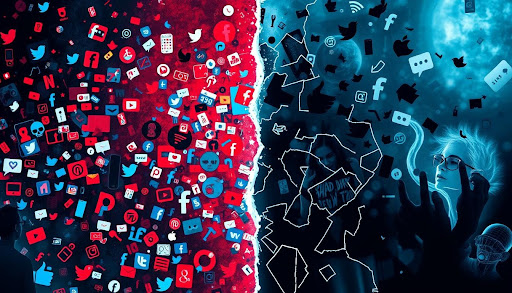Causes of political polarization
In today’s world, the gap between different political views is growing. This is known as political polarization. It affects our society deeply. Knowing what causes this divide is key to solving its problems.
At the core of political polarization is a big difference in values and beliefs. These differences often stem from economic, social, and cultural issues. This has led to big gaps between people’s views. The loss of bipartisan efforts and the rise of extreme views have made it harder to find common ground.
We need to understand what causes this divide. It’s not just one thing. Social media, income gaps, and where people live all play a role. Each factor adds to the complexity of political polarization.
Key Takeaways
- Political polarization is a growing phenomenon characterized by the widening gap between different ideological camps.
- Factors contributing to the partisan divide include economic disparities, social and cultural differences, and the erosion of bipartisanship.
- The role of social media and information bubbles, as well as geographic and educational divides, further exacerbate the problem.
- Understanding the complex interplay of these factors is crucial in addressing the challenges posed by political polarization.
- Bridging the divide and fostering greater political unity remains a significant challenge in modern society.
Understanding Political Polarization in Modern Society
In recent years, the world has seen a worrying trend of political polarization. This is when political talks become more split, with people holding to very extreme views. This split in politics affects how we govern, how we get along, and the health of our democracies.
Defining Political Division and Its Impact
Political polarization means the gap between different political groups is growing. People and groups are sticking to very different views. This partisan conflict leads to stuck decisions, no agreement on big issues, and less social cohesion. It makes it hard to find common ground and agree.
Historical Context of Political Discord
While political fragmentation isn’t new, its current level is. It’s due to many factors like history, society, and technology. The breakdown of old political ties, the rise of identity politics, and the divisive nature of public talks have all played a part. This has led to the strong political tribalism we see today.
Key Indicators of a Polarized Society
- Widening ideological divides between political parties and their supporters
- Increased hostility and mistrust between opposing political factions
- Declining willingness to engage in constructive dialogue or compromise
- Geographic sorting, with individuals gravitating towards like-minded communities
- Prominent role of media echo chambers in reinforcing partisan narratives
As political polarization shapes our modern politics, it’s key to understand its causes and effects. We need to work together to make our society more inclusive and united. The way forward is to bridge the gaps, boost social cohesion, and make our democracy stronger.
The Role of Social Media in Deepening Political Divides
Social media has become a key place for political talks, often making things more divided. The rise of echo chambers and filter bubbles has created spaces where people mostly see content that agrees with them. This can make political gaps wider, as people get less exposed to different views.
The fast spread of viral misinformation on social media can deeply affect what people believe and decide. Algorithmic bias in how social media picks content can also help some stories get more attention while others get less. This can make digital tribalism and political divisions stronger.
- The formation of echo chambers and filter bubbles on social media platforms can create an insular political discourse, limiting exposure to diverse perspectives.
- Viral misinformation, often driven by sensationalism and confirmation bias, can shape public opinion and political discourse in concerning ways.
- Algorithmic content curation on social media platforms can prioritize and amplify certain narratives, potentially contributing to the deepening of political divides.
As social media’s role in politics grows, it’s key to grasping and tackling these problems. We need a more open and inclusive political scene.
“Social media has become a breeding ground for political echo chambers, where users reinforce their existing beliefs and become increasingly disconnected from opposing viewpoints.”
Causes of Political Polarization in America
The divide in American politics is due to economic, geographic, and educational factors. It’s important to understand these causes to tackle the growing divide in the country.
Income Inequality and Political Views
The wealth gap in the U.S. is a major cause of political polarization. As the gap widens, so do the political views and voting patterns. The rich often support policies that help them, while the poor back social welfare and progressive policies.
Geographic Sorting and Ideological Bubbles
“Geographic sorting” has also contributed to the divide. People with similar views and backgrounds tend to live in the same areas. This creates bubbles where only certain views are heard, making divisions deeper.
Educational Disparities and Political Beliefs
The educational level also shapes political beliefs. Research shows that better-educated people lean towards progressive views. Those with less education tend to be more conservative. This educational gap adds to the urban-rural divide and deepens the ideological segregation.
| Socioeconomic Factor | Impact on Political Polarization |
| Wealth Gap | The widening wealth gap leads to divergent political views and voting patterns |
| Geographic Sorting | Ideological clustering in specific regions reinforces existing beliefs |
| Educational Attainment | Higher education levels are associated with progressive views, lower levels with conservative positions |
“The growing divide between the haves and the have-nots is a significant contributor to the polarization we see in American politics today.”
To bridge the political divide, we must tackle these complex factors. This will help create a more united and collaborative society.
Media Echo Chambers and Information Bias
In today’s digital world, partisan media and news polarization have made political divisions deeper. The rise of media fragmentation has created separate information bubbles. These bubbles make people mostly see content that matches their beliefs.
Confirmation bias is key to understanding these echo chambers. People usually look for news that fits their political views, a process called selective exposure. This makes it hard to find common ground with others who have different beliefs.
- Social media has made things worse, as algorithms focus on content that gets more clicks, not always balanced news.
- Traditional media is also under pressure, leading some to focus more on their audience’s views than on being impartial.
- This has made public discussions more divided, with people in their own information worlds. It’s hard to find common ground and have meaningful talks.
It’s vital to tackle media echo chambers and information bias to unite our society. We need a more informed public, open to different views and critical thinking. This could help us move towards a more united political scene.
“The echo chamber effect is a real phenomenon and it has a profound impact on our political discourse. It’s essential that we find ways to break down these information silos and expose ourselves to a wider range of perspectives.”
Cultural and Identity Politics in Division
Political polarization in the United States is tied to cultural and identity-based factors. These factors have become key in dividing people along party lines. Religious beliefs, racial and ethnic dynamics, and the urban-rural divide all shape political views and voting patterns.
Religious Influences on Political Views
Religion and politics are closely linked in America. Religious conservatives, especially evangelical Christians, support the Republican Party. They stand for traditional values and defend religious freedoms. On the other hand, those who lean more liberal and secular often vote for the Democratic Party. They focus on social justice and keeping church and state separate.
Racial and Ethnic Factors
Racial and ethnic identities have a big impact on politics. As the U.S. becomes more diverse, politics are changing. The rise of racial and ethnic minorities has challenged old power structures. This has led to more divisive rhetoric and policies aimed at certain groups, increasing political tensions.
Urban-Rural Divide in Political Ideology
The gap between urban and rural areas is growing in politics. Cities, with their diverse and educated populations, tend to vote liberal. Rural areas, with their conservative views, stand in contrast. This divide has made cultural and economic differences more pronounced, creating two Americas with different political identities.
FAQ
What are the main causes of political polarization?
Political polarization comes from many sources. These include income gaps, where people live, education levels, and media. Cultural differences and identity politics also play a big role.
How does social media contribute to political divides?
Social media helps create echo chambers. It spreads false information and shows content that matches what you already believe. This makes political divides worse.
What role does the media play in political polarization?
Media can make things worse by showing only what you agree with. This leads to more division. It also breaks down common ground.
How do cultural and identity factors influence political ideology?
Things like religion, race, and where you live shape your political views. They show how identity and politics are connected.
What are the key indicators of a polarized society?
Signs of a polarized society include more conflict and extreme views. It also shows less social unity and more political tribalism






